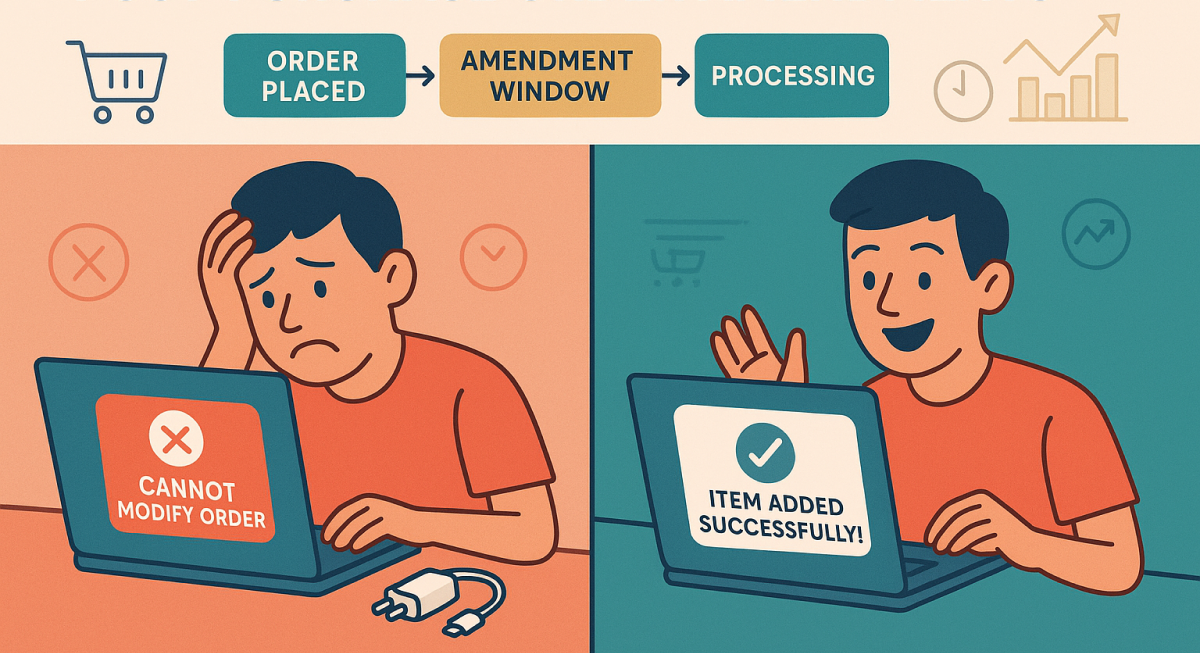Why Retailers Should Support Post-Purchase Order Amendments

A Missed Opportunity in E-commerce
I recently had an experience that got me thinking about a significant missed opportunity for online retailers. Minutes after placing a substantial order that qualified for free shipping, I realized I'd forgotten an essential item. When I went to add it, I discovered I'd need to place a separate order, incurring shipping costs that nearly matched the price of the item itself.
Naturally, I reached out to customer service, hoping for a simple solution. Instead, I was directed to the company's delivery terms and conditions, which explicitly stated that orders couldn't be amended after placement. While I understand the operational reasoning behind this policy, it transformed what had been a positive shopping experience into a frustrating one.
I briefly considered canceling my entire order and starting fresh, but that would trigger payment processing fees for the retailer—an outcome that seemed unnecessarily punitive to a business I wanted to support. This experience highlighted a common blind spot in e-commerce strategy: the inability to amend orders after checkout is costing retailers both customer satisfaction and additional sales.
Learning from Grocery Retailers
UK supermarkets like Waitrose have already solved this problem elegantly. They allow customers to modify orders up until a set cutoff time (typically the evening before delivery). This customer-friendly approach acknowledges the reality that shoppers often remember additional items after completing their initial order.
This model can—and should—be adapted by traditional e-commerce retailers. Most modern e-commerce platforms such as Ucommerce and DynamicWeb already support sophisticated order status workflows that could easily accommodate an amendment window.
A Simple Implementation Strategy
When we configure e-commerce stores for our clients, particularly in Ucommerce, we encourage implementing an interim status between "order placed" and "processing." This buffer gives customers flexibility to modify or even cancel orders without disrupting warehouse operations.
Since most online shopping happens outside business hours anyway, this approach creates a natural amendment window that aligns with existing operational patterns. Orders placed in the evening could remain amendable until the next business morning when fulfillment typically begins.
The technical aspects of processing additional payments are straightforward. Using a tokenized payment system like Stripe, retailers can simply charge the difference between the original and modified order. Even if retailers wanted to add a small convenience fee for amendments, customers would still save compared to separate shipping costs not to mention the retailer only subsidises a single order's shipping rather than two —creating a win-win scenario.
Hidden Benefits: Order Consolidation
Taking this concept further, we advise our retail clients to identify opportunities to consolidate multiple orders during their pick-and-pack process. By matching orders from the same customer e.g. by postcode, email and name within a specific timeframe, retailers can combine shipments that would otherwise ship separately.
This simple consolidation strategy has saved some of our clients thousands of pounds in shipping costs annually —an operational efficiency that directly improves the bottom line.
The Real Value Proposition
Beyond the immediate customer satisfaction benefits, supporting order amendments creates additional sales opportunities. Customers who realize they've forgotten items become potential upsell targets rather than frustrated shoppers. The amendment process itself is an opportunity to recommend complementary products or highlight promotional offers.
Furthermore, customers who know they can easily modify orders tend to complete their initial purchase more quickly, reducing cart abandonment rates. The psychological safety of knowing "I can always add something later" removes a significant friction point in the purchase decision.
Conclusion
In today's competitive e-commerce landscape, retailers need every advantage to build customer loyalty. The ability to amend orders post-purchase is a surprisingly overlooked feature that delivers significant customer satisfaction while potentially increasing average order values.
When implementing this capability for our clients, we've consistently seen positive feedback from both the operational and customer-facing sides of the business. It's a relatively simple technical enhancement that delivers outsized returns in customer goodwill and sales opportunities.
Has your business considered implementing order amendments? I'd be interested to hear about your experiences or concerns with this approach.
